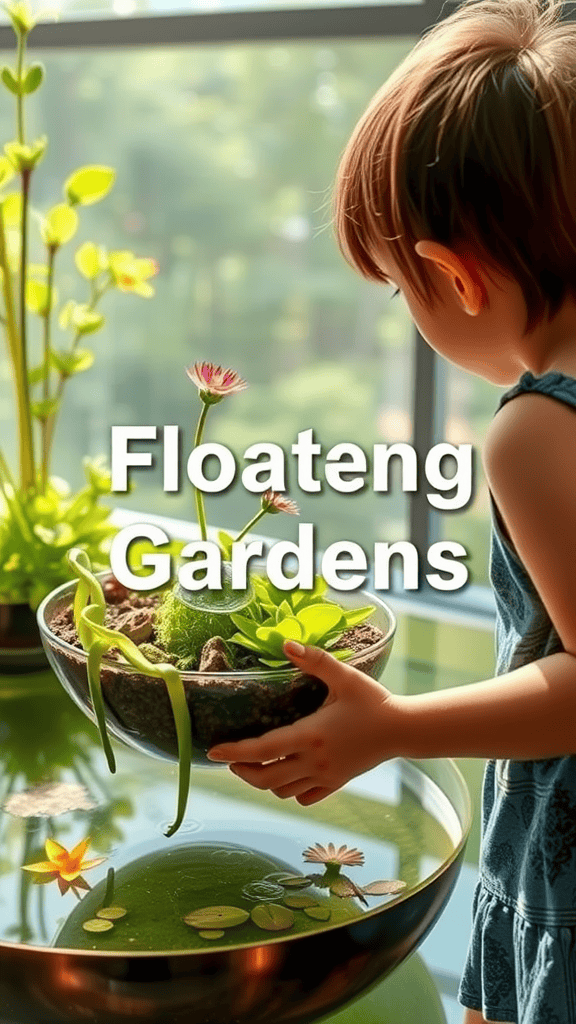Creative Techniques for Building Floating Gardens with Kids
Building floating gardens with kids is a fantastic way to blend creativity with science and nature. It’s an engaging project that not only teaches children about gardening but also fosters a sense of responsibility as they care for their plants. Let’s explore some creative techniques you can use to create these unique gardens with your children.
Choosing the Right Materials
The first step to successfully create a floating garden is selecting the right materials. Here are some ideas:
- Foam Layers: Use lightweight foam sheets to provide buoyancy. Cut these into the desired shapes and sizes for your garden base.
- Raised Planters: Consider using small containers like plastic bins or buckets. These can be filled with soil and float on the water’s surface.
- Natural Materials: Old boat parts, bamboo, or wood can also be used to give your garden a rustic look. Just ensure they are treated or preserved to resist water damage.
Floating Base Creation
Once you have your materials, the next step is to build the floating base. Here’s a simple method:
- Cut Your Foam: Start by cutting the foam into rectangular or circular sections that can float.
- Secure the Containers: If you’re using containers, secure them to the foam with strong adhesive or waterproof tape.
- Test for Buoyancy: Before planting, place your base in water to check its buoyancy. Adjust as necessary by changing the container weight or foam size.
Plant Selection
Now that you have your floating base ready, it’s time to select plants. Choose plants that thrive in water or can tolerate wet conditions. Here are some great options:
- Water Lilies: Beautiful and offer shade and shelter for other plants.
- Lotus: Has stunning flowers and adds elegance to any floating garden.
- Herbs: Basil, mint, or chives can be grown in between water-loving plants, providing both beauty and utility.
- Succulents: Some varieties can handle moist soil, making them good companions in a floating garden.
Planting Technique
With your plants chosen, it’s time to plant them! Follow these steps for effective planting:
- Prepare the Soil: Fill your containers with a mix of potting soil and compost. This will help your plants thrive.
- Planting: Create small holes in the soil and gently place the plants in. Make sure to cover their roots well and press the soil lightly around them.
- Watering: Since the base is floating, water the plants lightly to settle the soil. Avoid overwatering.
Caring for Your Floating Garden
Once your floating garden is set up, proper care is essential. Here are some tips to keep it thriving:
- Regular Monitoring: Check the plants daily for growth and health. Look out for dry soil or wilting leaves.
- Fertilizing: Use a water-soluble fertilizer every few weeks to provide essential nutrients.
- Pest Management: Keep an eye out for pests. If you spot any, gently wash them off with water or use insecticidal soap.
Makin’ It Fun!
Creating floating gardens can be an enjoyable activity for kids. Here are some fun ideas to involve them even more:
- Garden Themes: Encourage kids to create themed gardens, like a fairy garden or a vegetable garden, using miniature decorations.
- Artistic Touches: Let them decorate the floating bases with paint or natural items like shells and rocks.
- Learning Moments: Use this opportunity to teach kids about the water cycle, photosynthesis, and ecosystems.
Floating gardens not only beautify your space but also provide an interactive environment for learning and creativity. Involving your kids in this project will foster a deeper appreciation for nature, encourage imaginative thinking, and create lasting memories. So grab your materials, get planting, and enjoy the wonderful world of floating gardens together!
The Educational Benefits of Floating Gardens in Environmental Science
Floating gardens, a fascinating innovation in sustainable agriculture, provide numerous educational benefits that align seamlessly with environmental science. By engaging students with hands-on activities around floating gardens, teachers can cultivate curiosity and enthusiasm for ecological concepts.
Understanding Environmental Interaction
Creating and maintaining a floating garden helps students gain a better understanding of the relationships among various environmental components. Through exploration, they can witness:
- Water and Plant Dynamics: Children learn how plants absorb water and nutrients, emphasizing the role of water in supporting life.
- Habitat Creation: Floating gardens offer shelter to diverse species, illustrating the concept of ecosystems and their interdependence.
Promoting Critical Thinking
Students involved in designing their own floating gardens are prompted to think critically about various factors affecting growth and sustainability. They may ask:
- What types of plants thrive in these conditions?
- How can we optimize space and resources while minimizing waste?
By contemplating these questions, children develop problem-solving skills essential for scientific inquiry.
Hands-On Learning Experiences
Engagement with floating gardens offers several practical experiences that enrich learning. Students can participate in:
- Planting: Direct involvement in planting seeds fosters a sense of responsibility and ownership over the actual growth process.
- Monitoring Growth: Regularly observing the progress of their plants builds patience and teaches them to make scientific observations.
- Record Keeping: Keeping a journal of their floating garden’s development sharpens their data collection and analytical skills.
Interdisciplinary Connections
Floating gardens serve as an excellent platform for interdisciplinary connections in education. Subjects such as:
- Biology: Students learn about plant biology, including photosynthesis and cellular structures.
- Mathematics: Calculating water needs and determining the area for planting fosters practical application of math skills.
- Art: Designing and painting floating garden platforms can lead to creative expression and integration of aesthetics in nature.
Fostering Environmental Stewardship
Engagement with floating gardens instills a sense of environmental consciousness in young learners. When students observe the positive effects of sustainable gardening practices, they are more likely to:
- Advocate for Sustainability: Encourage peers and family to adopt environmentally friendly practices.
- Engage in Community Projects: Participate in local initiatives, spreading awareness about sustainable agriculture.
Encouraging Collaboration and Teamwork
Floating gardens are perfect for group projects. Students can work collaboratively, which enhances social skills such as communication, cooperation, and conflict resolution. They learn to:
- Share Ideas: Brainstorming together encourages a diverse range of solutions to challenges.
- Assign Roles: Working as a team allows individuals to take responsibility and contribute their strengths.
: Lifelong Learning Skills
The educational benefits of floating gardens extend far beyond the immediate experience of planting and growing. Students develop essential skills such as observation, teamwork, environmental awareness, and problem-solving. By integrating floating gardens into the curriculum, educators can effectively engage children in the wonders of environmental science, ensuring they grow into curious and responsible stewards of the Earth.
Conclusion
Creating floating gardens with kids is not only a fun and imaginative activity, but it also opens the door to numerous educational opportunities. By using creative techniques to construct these gardens, you encourage children to engage in hands-on learning while developing essential skills such as problem-solving, teamwork, and creativity. Whether it’s using recycled materials or experimenting with different planting methods, the process can spark a sense of wonder and curiosity about nature and gardening.
Moreover, floating gardens serve as an excellent teaching tool for environmental science. As children observe how plants grow in water, they can learn about ecosystems, water filtration, and the vital role of plants in our environment. By incorporating lessons on sustainability and biodiversity, you can foster a sense of environmental stewardship in young minds. Not only do floating gardens allow children to see nature in action, but they also inspire them to think critically about their impact on the planet.
Transforming your backyard or a local community space into a floating garden can create long-lasting memories and insights for your kids. This activity not only cultivates a love for gardening but also instills awareness about environmental issues. By merging creativity with education, you nurture future generations to become responsible caretakers of their surroundings, all while having fun. The journey of creating floating gardens is one filled with joy, learning, and growth—an unforgettable experience that can shape their perspectives for years to come.
As an Amazon Associate, I earn from qualifying purchases.

